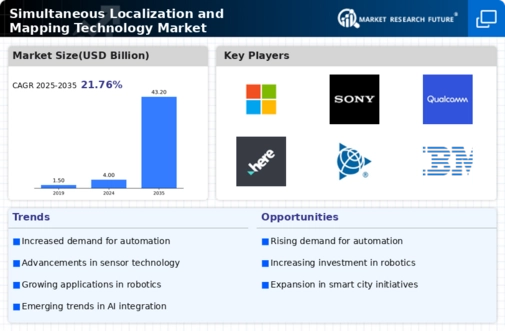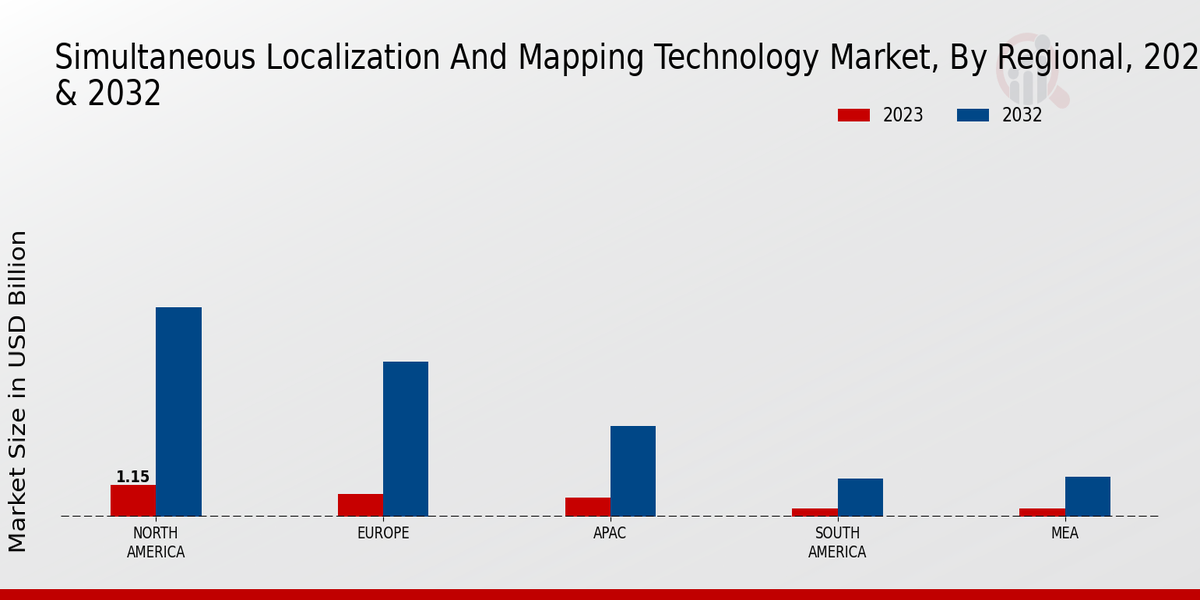Advancements in Robotics
Advancements in robotics are propelling the Global Simultaneous Localization and Mapping Technology Market Industry forward. Industries such as manufacturing, logistics, and healthcare are increasingly adopting robotic systems that require accurate localization and mapping capabilities. For example, warehouse robots utilize SLAM to navigate complex environments efficiently. This trend is likely to drive market growth, as the demand for automated solutions continues to rise. The market is anticipated to experience a compound annual growth rate of 24.14% from 2025 to 2035, indicating a robust expansion fueled by innovations in robotic technologies.
Market Growth Projections
The Global Simultaneous Localization and Mapping Technology Market Industry is poised for substantial growth, with projections indicating a market size of 4 USD Billion in 2024 and an impressive increase to 43.2 USD Billion by 2035. This growth trajectory suggests a compound annual growth rate of 24.14% from 2025 to 2035, reflecting the escalating demand for SLAM technologies across various applications. The market's expansion is driven by advancements in autonomous vehicles, robotics, smart cities, augmented reality, and the Internet of Things, positioning SLAM as a critical technology for future innovations.
Increased Investment in Smart Cities
The push towards smart city initiatives is significantly influencing the Global Simultaneous Localization and Mapping Technology Market Industry. Governments worldwide are investing in infrastructure that incorporates SLAM technologies for urban planning, traffic management, and public safety. For instance, cities are deploying SLAM-enabled drones for real-time mapping and monitoring of urban environments. This investment is expected to enhance the efficiency of city services and improve the quality of life for residents. As a result, the market is projected to grow substantially, with estimates suggesting it could reach 43.2 USD Billion by 2035.
Expansion of Internet of Things (IoT)
The expansion of the Internet of Things (IoT) is a significant driver of the Global Simultaneous Localization and Mapping Technology Market Industry. As IoT devices proliferate, the need for precise localization and mapping becomes increasingly critical for effective data collection and analysis. Smart devices in homes and cities utilize SLAM to navigate and interact with their environments. This integration enhances operational efficiency and data accuracy, contributing to the overall growth of the market. The ongoing evolution of IoT technologies is expected to further bolster the demand for SLAM solutions in various sectors.
Growing Adoption in Augmented Reality
The growing adoption of augmented reality (AR) applications is driving the Global Simultaneous Localization and Mapping Technology Market Industry. AR technologies rely heavily on SLAM for accurate spatial awareness and interaction with the real world. Industries such as gaming, education, and retail are leveraging SLAM to create immersive experiences. For example, AR applications in retail allow customers to visualize products in their environment before purchase. This trend is likely to accelerate market growth, as more businesses recognize the potential of SLAM in enhancing user engagement and experience.
Rising Demand for Autonomous Vehicles
The increasing demand for autonomous vehicles is a primary driver of the Global Simultaneous Localization and Mapping Technology Market Industry. As automotive manufacturers invest heavily in self-driving technology, the need for precise localization and mapping solutions becomes paramount. For instance, companies like Waymo and Tesla are integrating advanced SLAM technologies to enhance navigation and safety features. This trend is projected to contribute significantly to the market, with the industry expected to reach 4 USD Billion in 2024, reflecting the growing reliance on SLAM for vehicle autonomy.
















